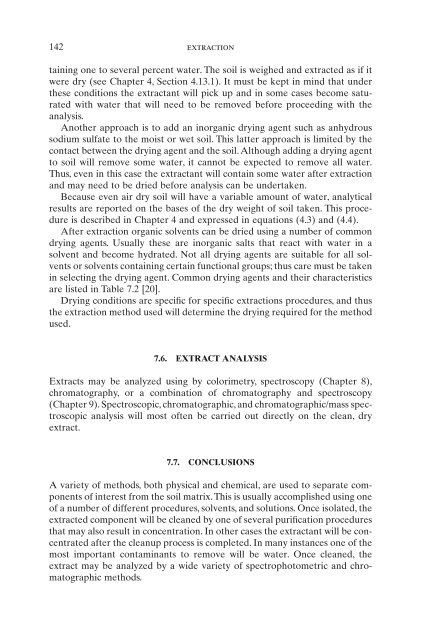Introduction to Soil Chemistry
Introduction to Soil Chemistry
Introduction to Soil Chemistry
Create successful ePaper yourself
Turn your PDF publications into a flip-book with our unique Google optimized e-Paper software.
142 extraction<br />
taining one <strong>to</strong> several percent water. The soil is weighed and extracted as if it<br />
were dry (see Chapter 4, Section 4.13.1). It must be kept in mind that under<br />
these conditions the extractant will pick up and in some cases become saturated<br />
with water that will need <strong>to</strong> be removed before proceeding with the<br />
analysis.<br />
Another approach is <strong>to</strong> add an inorganic drying agent such as anhydrous<br />
sodium sulfate <strong>to</strong> the moist or wet soil. This latter approach is limited by the<br />
contact between the drying agent and the soil.Although adding a drying agent<br />
<strong>to</strong> soil will remove some water, it cannot be expected <strong>to</strong> remove all water.<br />
Thus, even in this case the extractant will contain some water after extraction<br />
and may need <strong>to</strong> be dried before analysis can be undertaken.<br />
Because even air dry soil will have a variable amount of water, analytical<br />
results are reported on the bases of the dry weight of soil taken. This procedure<br />
is described in Chapter 4 and expressed in equations (4.3) and (4.4).<br />
After extraction organic solvents can be dried using a number of common<br />
drying agents. Usually these are inorganic salts that react with water in a<br />
solvent and become hydrated. Not all drying agents are suitable for all solvents<br />
or solvents containing certain functional groups; thus care must be taken<br />
in selecting the drying agent. Common drying agents and their characteristics<br />
are listed in Table 7.2 [20].<br />
Drying conditions are specific for specific extractions procedures, and thus<br />
the extraction method used will determine the drying required for the method<br />
used.<br />
7.6. EXTRACT ANALYSIS<br />
Extracts may be analyzed using by colorimetry, spectroscopy (Chapter 8),<br />
chroma<strong>to</strong>graphy, or a combination of chroma<strong>to</strong>graphy and spectroscopy<br />
(Chapter 9). Spectroscopic, chroma<strong>to</strong>graphic, and chroma<strong>to</strong>graphic/mass spectroscopic<br />
analysis will most often be carried out directly on the clean, dry<br />
extract.<br />
7.7. CONCLUSIONS<br />
A variety of methods, both physical and chemical, are used <strong>to</strong> separate components<br />
of interest from the soil matrix.This is usually accomplished using one<br />
of a number of different procedures, solvents, and solutions. Once isolated, the<br />
extracted component will be cleaned by one of several purification procedures<br />
that may also result in concentration. In other cases the extractant will be concentrated<br />
after the cleanup process is completed. In many instances one of the<br />
most important contaminants <strong>to</strong> remove will be water. Once cleaned, the<br />
extract may be analyzed by a wide variety of spectropho<strong>to</strong>metric and chroma<strong>to</strong>graphic<br />
methods.
















